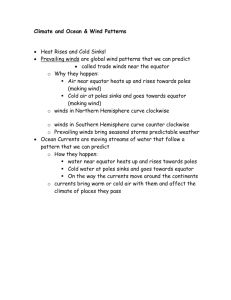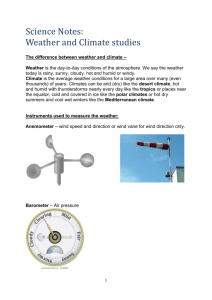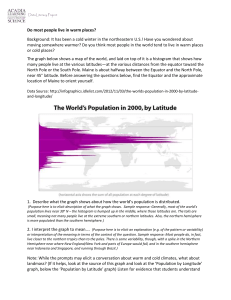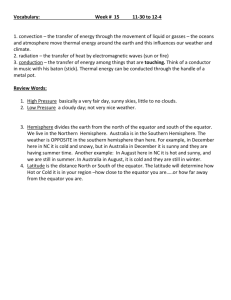Ch 7.3 Student Notes CD
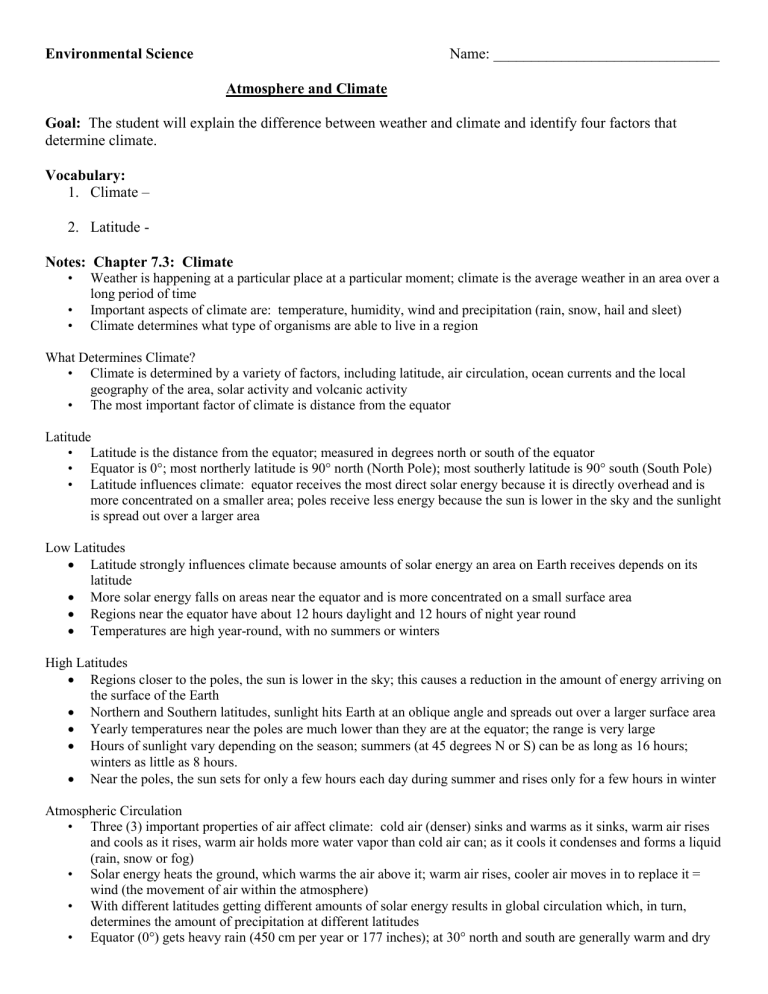
Environmental Science Name: ______________________________
Atmosphere and Climate
Goal: The student will explain the difference between weather and climate and identify four factors that determine climate.
Vocabulary:
1.
Climate –
2.
Latitude -
Notes: Chapter 7.3: Climate
•
Weather is happening at a particular place at a particular moment; climate is the average weather in an area over a long period of time
•
Important aspects of climate are: temperature, humidity, wind and precipitation (rain, snow, hail and sleet)
•
Climate determines what type of organisms are able to live in a region
What Determines Climate?
•
Climate is determined by a variety of factors, including latitude, air circulation, ocean currents and the local geography of the area, solar activity and volcanic activity
•
The most important factor of climate is distance from the equator
Latitude
• Latitude is the distance from the equator; measured in degrees north or south of the equator
• Equator is 0°; most northerly latitude is 90° north (North Pole); most southerly latitude is 90° south (South Pole)
• Latitude influences climate: equator receives the most direct solar energy because it is directly overhead and is more concentrated on a smaller area; poles receive less energy because the sun is lower in the sky and the sunlight is spread out over a larger area
Low Latitudes
Latitude strongly influences climate because amounts of solar energy an area on Earth receives depends on its
latitude
More solar energy falls on areas near the equator and is more concentrated on a small surface area
Regions near the equator have about 12 hours daylight and 12 hours of night year round
Temperatures are high year-round, with no summers or winters
High Latitudes
Regions closer to the poles, the sun is lower in the sky; this causes a reduction in the amount of energy arriving on the surface of the Earth
Northern and Southern latitudes, sunlight hits Earth at an oblique angle and spreads out over a larger surface area
Yearly temperatures near the poles are much lower than they are at the equator; the range is very large
Hours of sunlight vary depending on the season; summers (at 45 degrees N or S) can be as long as 16 hours; winters as little as 8 hours.
Near the poles, the sun sets for only a few hours each day during summer and rises only for a few hours in winter
Atmospheric Circulation
•
Three (3) important properties of air affect climate: cold air (denser) sinks and warms as it sinks, warm air rises and cools as it rises, warm air holds more water vapor than cold air can; as it cools it condenses and forms a liquid
(rain, snow or fog)
• Solar energy heats the ground, which warms the air above it; warm air rises, cooler air moves in to replace it = wind (the movement of air within the atmosphere)
• With different latitudes getting different amounts of solar energy results in global circulation which, in turn, determines the amount of precipitation at different latitudes
• Equator (0°) gets heavy rain (450 cm per year or 177 inches); at 30° north and south are generally warm and dry
(most deserts found here); at 60° winds are beginning to rise again and drop again around 90° causing very cold deserts
Global Circulation Patterns
Cool air normally sinks, but cool air over the equator cannot descend because hot air is rising below the cool air
Cool air is then forced away from the equator toward the poles
At 30 degrees north latitude and 30 degrees south latitude, air accumulates in the upper atmosphere; some air sinks back to Earth’s surface (gradually getting warmer) which moves across the surface, causing water to evaporate from the land, creating dry conditions
Air ascending at 30 degrees north and 30 degrees south latitude move toward the equator or flow to the poles, air moving toward poles warms while near the surface; at 60 degrees north and south latitude, the air collides with cold air traveling from the poles; the warm air rises, reaching the top of the troposphere, where a small part returns back into the circulation pattern between 60 degrees and 30 degrees north and south latitude. However, most of this uplifted air is forced toward the poles.
Prevailing Winds
Winds that blow predominantly in one direction throughout the year are called prevailing winds
Because of rotation of the Earth, they do not blow directly north or south but to the right in the Northern
Hemisphere and to the left in the Southern Hemisphere
Primarily produced between 30 degrees north and south latitude and the equator; these belts of winds are called trade winds; blow from northeast in the Northern Hemisphere; blow from the southeast in the Southern
Hemisphere
Prevailing winds known as westerlies are produced between 30 and 60 degrees north and south latitude; in
Northern Hemisphere these westerlies are southwest winds; in Southern Hemisphere they are northwest winds
Polar easterlies blow from the poles to 60 degrees north and south latitude
Lesson Reflection:
Use the diagram of the Earth to mark the direction of the winds based on the information given in your notes. Be sure to label them.
Assessment:
1.
Explain the difference between weather and climate.
2.
Name four factors that determine climate.
3.
Explain why different parts of the Earth have different climates.
Lesson Extension (Technology/Application/Connection to Real World):
Use Battleship game to reinforce latitude and longitude.

